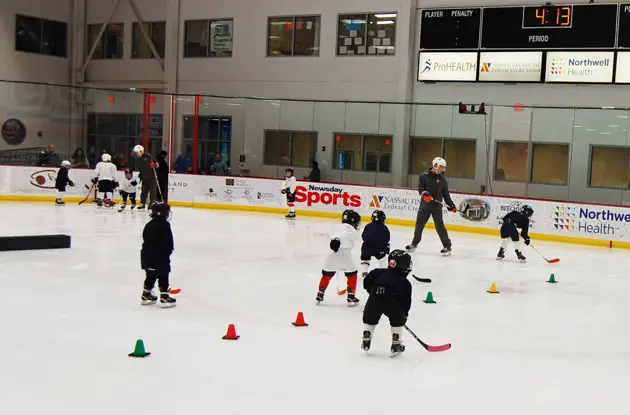A mother in a Larchmont sports store that caters to local young athletes’ popular team sports needed new equipment for her three children, ages 7 to 10, and suddenly felt overwhelmed. “When does all this stop?” she asked the manager, expecting his sympathy. To her surprise, he replied: “Age 12.”
Though the man’s answer was based on his experiences in his store, national statistics back him up, showing that 75 percent of all kids drop out of organized sports by age 12. Why? According to youth sports expert Scott Lancaster, it’s just not fun any more. Lancaster is senior director of youth football for the National Football League and has spent the past 15 years developing youth sports programs in both soccer and football. He is also a Somers father of four, and has combined personal experience as Soccer Dad with his professional experience to understand why kids drop out of sports — and to create programs that reverse the trend. In his newly released book, Fair Play: Making Organized Sports a Great Experience for Your Kids (Prentice Hall, $14.95), Lancaster points to flaws in the traditional youth sports system many of us have seen firsthand — negative coaching, hyper-competitiveness, unequal treatment, and too much bench time. With most children starting to play at age 4 or 5, a few years of that is plenty. Add to that league games, championships and travel teams, starting around third grade. The competition heats up tremendously, as kids as young as 8 are chosen in drafts by coaches (dads) who scout the playing fields to build the best teams. By early adolescence, most players have long been labeled as good, bad, or indifferent athletes. “The children are being held hostage by parents, coaches and the whole system,” Lancaster says. Unless a child is a top athlete from the start, it’s hard to be redeemed along the way, since the system — modeled on adult sports entertainment — rewards the best players, or the ones with the most parental involvement. But even the best players get cheated, being forced to play the position the coaches say they play best, rather than giving them a full experience of learning other positions. Meanwhile, the second string players hug the bench, or deal with not making the team in the first place. “Most parents echo the concern that their children are not active enough,” Lancaster says noting distractions such as video games, TV and computers. “Yet when it comes to sports, we push them away with our actions and attitudes — no matter how well intended we may be.” Ironically, Lancaster says, age 12 is just when children are becoming more receptive to coaching and are able to retain more information. Their bodies are still changing and growing, and it’s premature to have pegged them as athletic or not at this age. In Europe, a fertile ground for superb athletes, children do not play real games until age 12. Until then, Lancaster says, it’s free play, and work on fundamentals and skills. And when the kids start to play, it’s not to win — it’s to learn, and to learn every single position. The competition does not start for real until high school.
In Fair Play, proceeds from which will be donated to the Boomer Esiason Foundation for cystic fibrosis research, Lancaster presents an innovative blueprint and philosophy for communities to adopt. It is the one he has used in the NFL’s youth program, which has seen registration soar from 250,000 when he took over in 1995, to more than 4 million today. Among its features, Lancaster says: • Throw out the old structure — the drafts, games, travel teams and championships. Under the Fair Play program, which is geared to children ages 5-17, everyone — regardless of skill — gets equal play. Each child learns every position. The goal is to learn the fundamentals of the sport inside and out. This means being well-versed in plays, strategy and skills. Lancaster can suggest any number of games or clinics that will engage all ages and levels of players, from the novice to the elite. “Parents have to overcome their old mindset,” he says. “A community could start off using Fair Play’s philosophy as an alternative. But when parents see the drastic improvement in their children, and the fun they’re having, it will catch on with everyone.”
• Recruit all parents. “The idea is to engage parents as teachers of the game,” Lancaster says. “If you provide parents with the proper tools to teach one or two skills within an organized structure, you will create an additional and useful group of enthusiastic supporters — and not critical sideline parents.”
• Hold league-wide practices and clinics. Traditional games do not have to be the sole focus of a child’s experience, or the only way to experience success, Lancaster says. In his NFL youth program, for example, kids ages 6-7 play a game like Ultimate Frisbee, but with a football. Other competitive games that hone skills are geared toward kids of different ages.
• More Moms as Coaches “Mothers make terrific coaches — especially for football,” Lancaster says. “Moms are natural teachers, they’re nurturing, and they listen and learn along with the kids. This improves the whole experience for the child.”
Fair Play points proudly to a crew of 30 moms in Somers who coach football to local 12- to 14-year-olds. “The women aren’t embarrassed to admit they don’t understand something, and keep asking questions until they do,” says Lancaster, whose book addresses how to teach coaches who have never played the sport they’re coaching. So the coaches are learning, the kids are learning, and everyone is having fun. Which is, of course, the whole point.





















